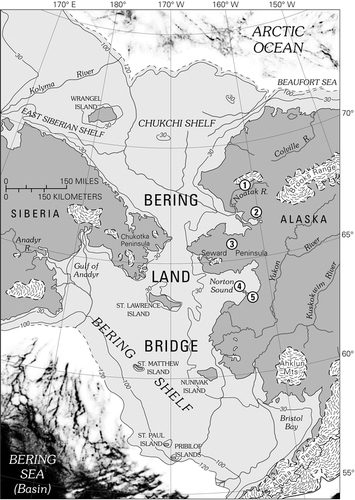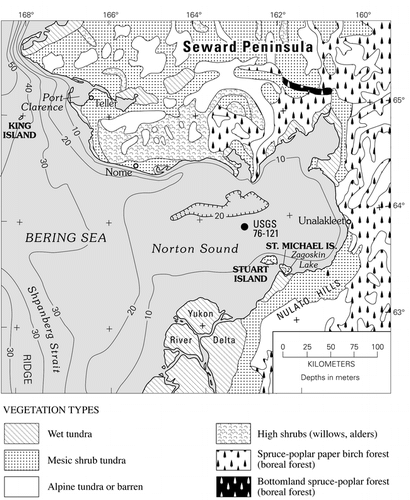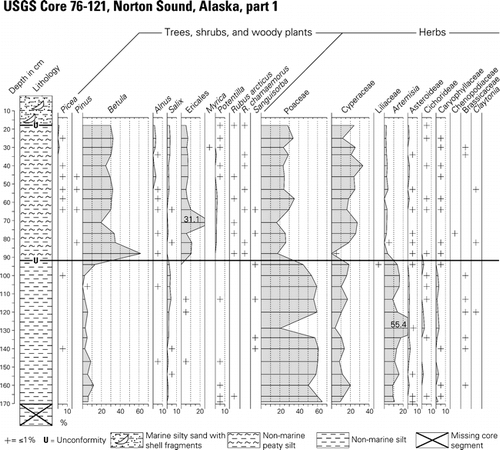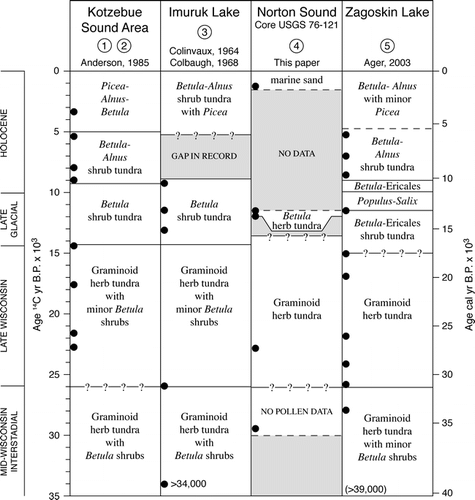Figures & data
Figure 1 Map of central Beringia, showing extent of Bering land bridge during the late Wisconsin maximum, ∼18,000 14C yr BP. Glacial ice extent is based on CitationKaufman and Hopkins (1986), CitationHamilton (1994), CitationVelichko et al. (1984), and CitationKaufman and Manley (2004). Key sites with pollen evidence for late Wisconsin vegetation discussed in this paper include (1) Kaiyak Lake, northwestern Alaska (CitationAnderson, 1985); (2) Squirrel Lake, northwestern Alaska (CitationAnderson, 1985); (3) Imuruk Lake, Seward Peninsula (CitationColinvaux, 1964; CitationColbaugh, 1968); (4) Core 79-121, Norton Sound (CitationMuhs et al., 2003; this paper); and (5) Zagoskin Lake, St. Michael Island (CitationAger, 1983, Citation2003).

Figure 2 Map of Norton Sound, northeastern Bering Sea, showing bathymetry (CitationSharma, 1979), and distribution of major (modern) vegetation types (CitationJFSLUPCFA, 1973). Also shown are: (1) site of USGS core 76-121; (2) St. Michael Island, site of Puyuk and Zagoskin Lake pollen records (CitationAger, 1982, Citation1983, Citation2003); (3) Village of St. Michael, site of climate data station (see ); (4) Village of Unalakleet, site of climate data station (see ); (5) City of Nome, site of climate data station (see ); (6) Village of Teller, site of climate data station ().

Table 1 Climate data (temperature and precipitation) from weather stations around Norton Sound.
Figure 3 Pollen and spore percentage diagram for USGS Core 76-121, central Norton Sound. Lithology column for the core is shown at the left of the diagram, and radiocarbon dates from the core are listed along the right margin, and in . See for location of the coring site within Norton Sound.

Table 2 Radiocarbon ages and calibrated ages for USGS core 76-121. Calibrations follow the Fairbanks 0107 calibration curve (CitationFairbanks et al., 2005). Data from http://radiocarbon.ldeo.columbia.edu/research/radiocarbon.htm on 21 September 2007. The marine reservoir correction for sample NOR-11 is based on data from CitationDumond and Griffin (2002). The USGS conventional bulk-sediment radiocarbon dates shown here were previously reported in CitationElias et al. (1996, Citation1997).
Figure 4 Chart comparing central Beringian vegetation histories derived from pollen records from (1) Kaiyak Lake and (2) Squirrel Lake near Kotzebue Sound, northwest Alaska (CitationAnderson, 1985, 1987); (3) Imuruk Lake, Seward Peninsula (CitationColinvaux, 1964; CitationColbaugh, 1968); (4) USGS Core 76-121, Norton Sound (CitationMuhs et al., 2003; this paper); and (5) Zagoskin Lake, St. Michael Island, Norton Sound (CitationAger, 1983, Citation2003).

